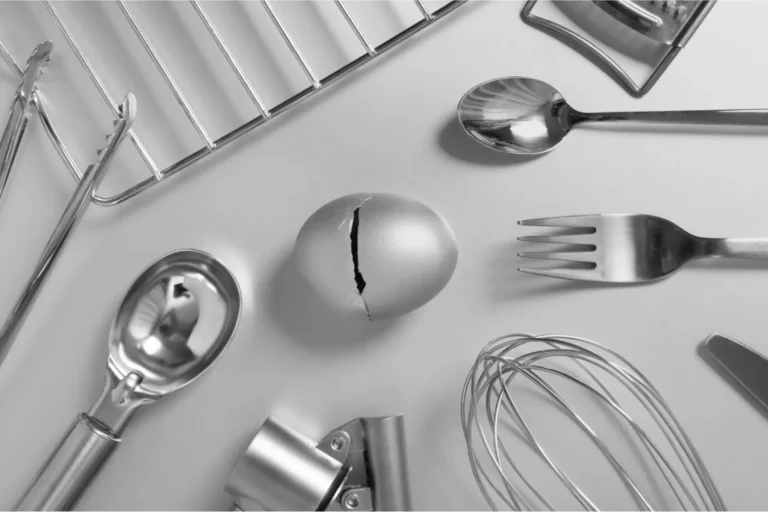Metals
We test, document and advise to ensure your products comply with applicable legal requirements.

Sikkerhed ved metaller i kontakt med fødevarer
At FCMtesting ApS in Odder, south of Aarhus, we ensure that your metal products comply with applicable EU regulations and national standards. We provide documentation so you can market your products safely and legally.
We offer:
- Release test for at sikre, at jeres produkt ikke afgiver metaller over de tilladte grænser.
- Declaration of Compliance according to EU regulations, so that your documentation is legally correct.
- Rådgivning om lovgivning og dokumentationskrav, så I opnår fuld compliance.
What should you be aware of when metal comes into contact with food?
When working with metal products for food contact, there are several practical and technical aspects worth knowing. At FCMtesting, we share the knowledge that makes it easier to make the right choices.
Acidic foods break down metal
Acidic foods such as tomato sauce, citrus fruits and fruit purees can break down the metal surface and release metals directly into the food. This is especially true for untreated metals such as aluminum, iron and copper. Water can also contribute to corrosion and leaching over time. This is why we talk about release instead of migration, when testing metals – because chemical decomposition occurs, not just diffusion.
The food industry often uses acid-resistant stainless steel types, but these are more expensive and not necessarily the right metal for all applications.
Some choose to coat the side of the metal that is in direct contact with the food, if acid-resistant metal is not used. This can be a lacquer, a polymer coating or some other form of barrier that protects against degradation and release. The choice depends on both the type of food and the use of the product.
What is a release test and when is it relevant?
Release tests measure how much metal is actually released into the food under realistic conditions. It can be lead, cadmium, nickel or other metals, depending on the composition of the product. We help you choose the right test method and interpret the results correctly, so you avoid errors and achieve full compliance.
Easy-to-clean metal surfaces
When using metal in industrial food production, surface finish is crucial. Smooth, non-porous surfaces are easier to clean and less likely to retain food residue and bacteria. Avoid acidic cleaning agents and ensure that the surface is resistant to the cleaning routines used in your production.
FIND MORE INFORMATION ABOUT METAL PRODUCTS
What types of materials are there?
Metal types used for food contact
- Stainless steel – Corrosion-resistant and durable, especially AISI 304 and AISI 316 (acid-resistant).
- Aluminum and aluminum alloys – Lightweight and heat conductive, often requires coating or anodizing.
- Copper and copper alloys (brass, bronze) – Requires regulation due to copper ions.
- Iron and cast iron – Used for pots and pans, protected with coating or seasoning.
- Tin and tin-plated materials – Typically in cans, requires lacquer coating against migration.
- Zinc and galvanized metals – Rarely in direct contact, used in containers and pipes.
- Silver and precious metals (gold, platinum) – Mostly for cutlery and decoration, has antibacterial properties.
Legislation and external references
Legislation and guidelines for metals
Tip: Always use the latest legal text. Select "In force" and the latest consolidated version on EUR-Lex.- Regulation (EC) No. 1935/2004: General requirements for safety and traceability for all materials, including metals.
- Regulation (EC) No. 2023/2006: The GMP regulation – ensures good manufacturing practices.
- Resolution CM/Res(2020)9: Recommendations for metals – migration, labeling and documentation.
- Danish executive order: National requirements for documentation and traceability.
FAQ – Testing and documentation of metal
FAQ – Testing and documentation of metals
- Does stainless steel need to be tested for food contact?
- Yes. It is tested for nickel and chromium, especially when in contact with acidic foods. See framework regulation 1935/2004.
- Are there differences in the requirements for aluminum and iron?
- Yes. Aluminum has specific limit values and is often assessed based on BfR's recommendationsIron is assessed based on general principles and tests for heavy metals.
- What metals and alloys are typically tested?
- Stainless steel, aluminum, iron, copper, brass, tin and zinc. The test depends on the application and surface treatment.
- Are there requirements for documentation and traceability?
- Yes. All metal products must have a Declaration of Compliance (DoC). See guide to DoC.
- What advantages do metals have as food contact materials?
- They are durable, heat-resistant and easy to clean – suitable for both industry and household use.
